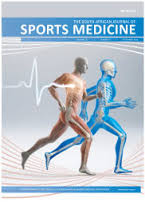Presenting features of female collegiate sports-related concussion in South Africa: a descriptive analysis
DOI:
https://doi.org/10.17159/2078-516X/2021/v33i1a10416Abstract
Background: Sports-related concussion (SRC) is an injury with important implications, especially in collision and contact sports, and has a high symptom burden. Student athletes face particular psychosocial challenges, especially female students with pre-existing anxiety/depression are at increased risk for SRC, and have a higher symptom burden before and after injury.
Objectives: Describing female SRC presenting features at a collegiate campus-based sports medicine service; examining the association of prior concussion history (PCONC) and pre- existing anxiety/depression (PMHDx) with SRC.
Methods: A retrospective cohort and statistical analysis (including corrected effect sizes) of Sport Concussion Assessment Tool (versions 3/5) data (Step 1: PCONC and PMHDx history; Step 2: symptom evaluation) of collegiate female athletes with SRC between 2012 and 2018.
Results: Forty females with SRC were identified (age 23 ± 3). The five most frequent symptoms were headache (n = 34; 85%), feeling slowed down (n = 33; 83%), pressure in head (n = 33; 83%), don't feel right (n = 32; 80%) and fatigue/low-energy (n = 32; 80%). These five symptoms also had the highest self-rated severity (median (IQR): headache (3 (2-4)), feeling slowed down (3 (1-4)), fatigue/low-energy (3 (1-5)), don't feel right (3 (1-4)) and pressure in head (3 (2-4)). PMHDx (n = 8; 62.9 vs 38.6; p = 0.0192; Hedges' gs = 0.95; large ES), and not PCONC (n = 13; 51.0 vs 39.8; p = 0.2183; Hedges' gs = 0.48; small ES) was associated with increased mean total symptom severity.
Conclusion: Headache, feeling slowed down, pressure in head, don't feel right and fatigue/low-energy had the highest symptom burden. Total symptom severity was no different in those with and without PCONC, but significantly higher in those with PMHDx.
Downloads
Downloads
Published
Issue
Section
License
The South African Journal of Sports Medicine reserves copyright of the material published. The work is licensed under a Creative Commons Attribution 4.0 (CC BY 4.0) International License. Material submitted for publication in the South African Journal of Sports Medicine is accepted provided it has not been published elsewhere. The South African Journal of Sports Medicine does not hold itself responsible for statements made by the authors.
How to Cite
- Abstract 504
- PDF 400





.png)